| Home Places to See | First Posted: May 27, 2013 Jan 21, 2020 | |
Hunt Country Stable Tour/Middleburg/Upperville/2013See also Some Past Hunt Country Stable Tours: Every year Middleburg and Upperville have a Hunt Country Stable Tour. It is a self-driven auto tour that usually takes place Saturday and Sunday of the Memorial Day Weekend. This is a special opportunity to see some of the most elegant farms and stables in the country while supporting good works. It is a benefit for the Trinity Church. The benefits from this event go to support the mission and ministries with special emphasis on outreach. Trinity Church was built in the style of a medieval French provincial church. It is an adaptation of a church built in the 12-13 century.. The Church was built from native Virginia sandstone. The office and parish hall were given to Meade Parish by Mr. and Mrs. Paul Mellon in 1960. Trinity Episcopal Church Upperville
The following is a direct quote from the 49th Annual Hunt Country Stable Tour, 2008, brochure: About Upperville
"Upperville has been described as 'a mile long and an inch wide.' The 18th century linear village began life in 1790 as Carr Town. {This hamlet was originally known as 'Carrtown', named for Joseph Carr, the mill owner, who owned 108 acres at the west end of town.} By the time the first post office opened in 1807, the name was Upperville. Today's quiet village shows few traces of the once bustling commerce along Route 50 that served its 300 residents. Although the population has barely changed, Upperville is now the center of America's famed 'Hunt Country' and surrounded by internationally recognized Thoroughbred farms. It lies within the Piedmont Hunt. Just east of town are the famous show grounds of the Upperville Colt and Horse Show, the oldest horse show in the United States. Established in 1853 by Colonel Richard Henry Dulany, this five-day event draws the best equestrians in the country to its hunter and jumper competitions, and is capped by the exciting $100,000 Budweiser/Upperville Jumper Classic. Upperville has been designated an Historic Landmark by the Virginia Landmark Commission." About Middleburg
"Middleburg, known by Colonial Virginians in 1731 as Chinn's Crossing, was originally owned by a cousin of George Washington. In 1787, the Virginia Assembly established the town, which had become a mid-way overnight stop on the pike between Alexandria and Winchester. Fittingly, its name was changed to Middleburg. The village is rich in history, from tales of Mosby's Rangers and skirmishes during the Civil War, to the glamorous years, when the Kennedy's were regulars, to its current international reputation as a breeding, showing, and racing center for Thoroughbreds. Country life and traditions are prized by local residents. The hunt and the hounds, carriage, drives, polo, charity balls, and walks along peaceful back roads make up the fabric of Middleburg life, along with delightful boutiques, art galleries, fine restaurants, and historic inns. In 1905, the Middleburg-Upperville areas created a renaissance in American fox hunting with the International Hound Trials. The riders and their hounds, with all their pomp and pageantry, lead off the annual Christmas parade in Middleburg." This poem by John Updike, "Upon Learning That a Town Exists in Virginia Called Upperville," appeared in the New Yorker on May 20, 1961. In Upperville, the upper crust One-upmanship is there the rule High hamlet, ho!-my mind's eye sees Depression never dares intrude I've always known there was a town 2013 Hunt Country Stable Tour-Middleburg and Upperville*New places that we had not seen in the past. This year my husband and I were able to make it to the stable tour. We went on Sunday; the day was glorious--sun shining, soft breeze, and no bugs. Bill and I made reservations for a wonderful Sunday brunch at Goodstone Inn to break up the tour. We did not visit all of the places on the tour as we have seen them many times before; however, there were several new horse farms which we had not seen in previous years. Here is the slate of items to see: Ardarra Farm*, Banbury Cross Farm*, Heronwood Farm, MARE Center, Middleburg Training Track, National Sporting Library and Museum, Peace and Plenty at Bollingbrook*, Rock Hill Farm, Salem Farm*, Trappe Hill Farm, Virginia International Polo Club and Windsor Farm*. Trinity Episcopal Church is also open and serves a purchased box lunch, as well. We began at the MARE Center even though we have been there many times in the past. They demonstrated how they gentle the foals as well as the use of the treadmill for horses. Along with the demonstration there was a wonderful narrative with question and answer time. It is always enjoyable and educational. Middleburg Agricultural Research and Extension Center (M.A.R.E. Center)
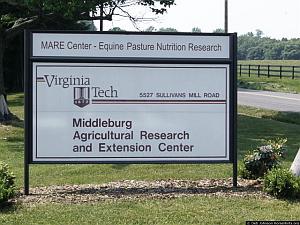 Situated at the heart of Virginia's horse country, The MARE Center The MARE Center plays a critical role in the discovery, outreach and education missions of Virginia Tech's College of Agriculture and Life Sciences. Much of today's current knowledge about equine nutrition, exercise physiology and the growth of young horses is the result of the cutting-edge research and innovation carried out at this world-class facility. In 2010, the center has launched a new initiative: an undergraduate student learning experience in equine sciences that will serve as the cornerstone for its teaching program. The novel, cutting-edge educational experience will immerse students in an environment filled with horses for an entire semester. It builds upon the strong scientific and practical foundation that Virginia Tech students receive as part of their curriculum on the Blacksburg campus, and prepares them for future careers in the horse industry, or in the veterinary and scientific fields. Along with the normal demands required by a structured curriculum, students participate in all aspects of the daily operations of a large-scale equine breeding, show, and sales facility. Additionally, they have the opportunity to take part in in-depth summer internship programs, as well as a European study abroad course. To further support the new program, Virginia Tech has relocated its internally-recognized sport horse breeding program from Blacksburg to the MARE Center. 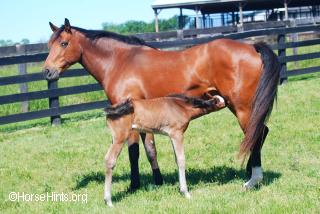 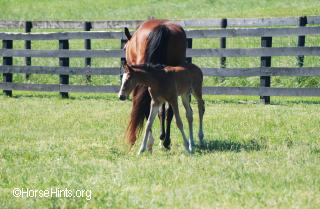   Mare and Foal at the MARE Center/Middleburg, VA/2013 Hunt Country Stable Tour 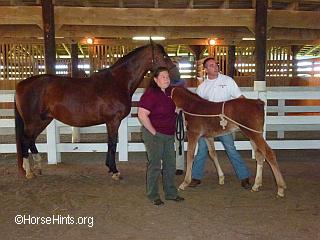 Working with a foal 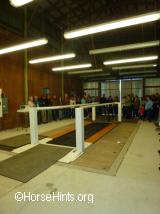  Horse treadmill and horse on treadmill at the walk (warming up) 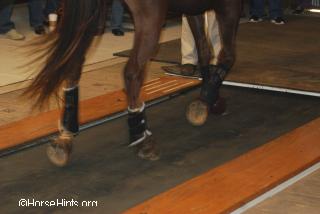 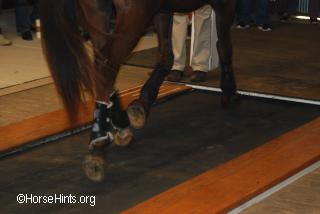 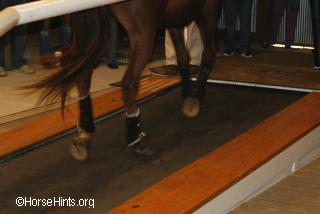 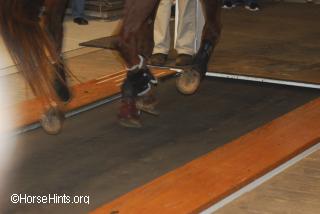  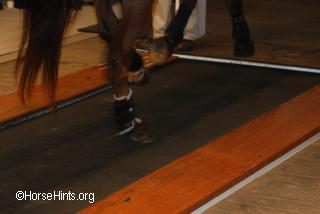 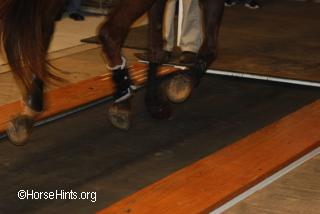 Horse working out on treadmill/Look at the footfalls. Ardarra Farm* 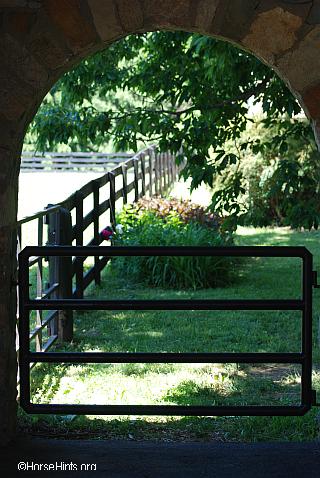 Lovely Ardarra Farm/So welcoming!
The Orange County Hounds territory of the Virginia Piedmont is the backdrop for Ardarra Farm, a Colonial Revival, country home estate inspired by Mount Vernon. The stable and related outbuildings were designed for foxhunting enthusiast Robert McConnell by the New York firm of Penrose V. Stout and constructed by local craftsman W.F. Hanback in 1931. All the buildings, after undergoing extensive restoration, were listed on the National Register of Historic Places is 2002. The 240-acre property, dedicated to wildlife preservation and the continuation of foxhunting, was placed under conservation easement with the Virginia Outdoors Foundation in 2000. Just this year, the owners, Steve and Susanne Lamb, in their quest to further preserve the land and environment, installed solar panels on the sable roof. These panels provide all the energy used in the stable operation. Susanne, an avid follower of the hunt, has filled the 12-stall, courtyard style barn with Irish Draught hunting horses. Susanne also breeds and trains this rare and historic breed of horse, known for its gentle disposition, intelligence and versatility.
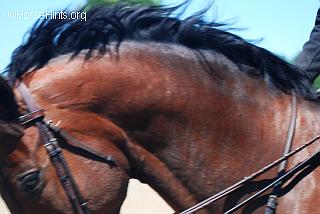 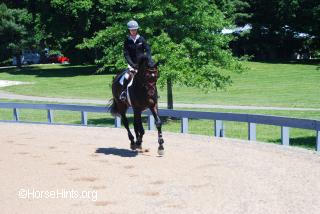 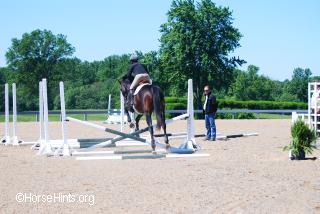 Alexa Lowe Wiseman was explaining the training of the young horses, etc. while a rider demonstrated the horse's movements and jumping ability. The three horses were wonderful forward movers, willing and enjoying their work. They "floated" effortlessly. It was lovely to watch. 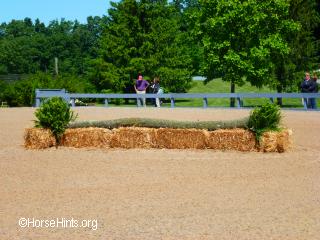 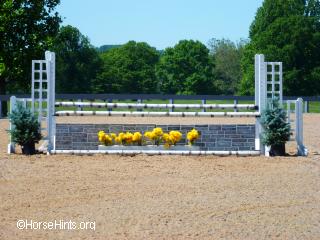 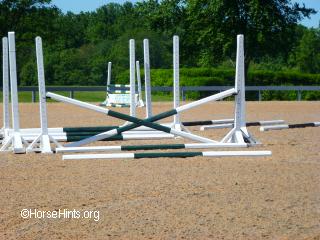 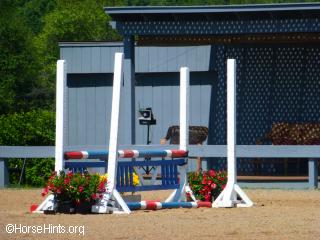 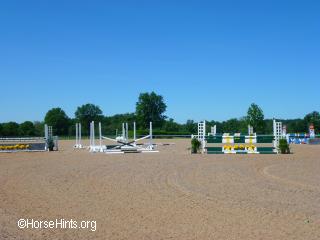 Windsor Farm is a 180-acre equestrian breeding, training and sales facility in Upperville, VA. The farm, owned by Margaret and Francis O'Neill and their daughters, Alexa Lowe Wiseman, is in the heart of Virginia horse country. The farm presently has for sale over 50 horses, which include brookmares that have competed successfully, imported home-bred foals, youong horses in training, and proven show jumpers. The farm is fortunate to have Alex Korompis, who, after 30 years experience in European show jumping and breeding, works on finding good young prospects and proven jumpers and oversees the breeding program. Windsor Farm offers to the horse industry knowledge and consultation regarding breeding horses. Their horses compete at most major east coast Horse Shows, including in Wellington, Florida from January thrugh March, usually with at least eight jumpers competing at the Winter Equestrian Festival. Windsor is a collection of lush pastures, stables, and training facilities. Young horses have planty of space to run and grow until the age of three. In the spring of their third year, they are broken for simple basics. Our most promising three-year-old mares are then bred and go back into training after their foals are weanted. The young colts and geldings are left to play until they reach four and are proven. Older brood mares get a short rest until their next foal arrives. At four years, the young horses come in for full training. Windsor gives them a thorough dressage education before they begin their jumping career. Their first jumps are in our free jumping pen where they learn through natural instincts without being inhibited by a rider. Once they are well schooled in dressage and free jumping, their career jumping under saddle begins! Bill and I were fortunate to be able to observe Alexa Lowe Wiseman school three of Windsor's young prospects through gymnastics in the main arena. It was quite educational as well as lovely to watch these magnificent animals train. Peace and Plenty at Bollingbrook  Peace and Plenty at Bollingbrook 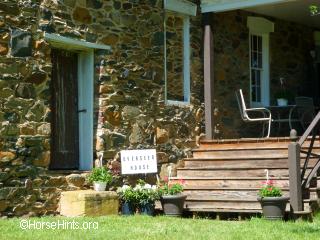 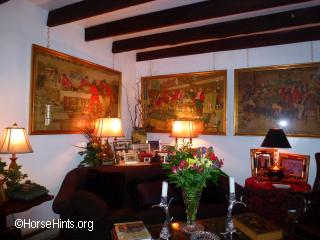 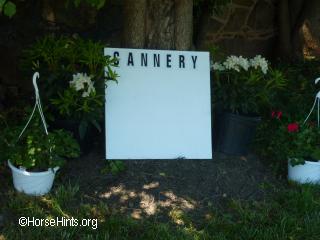 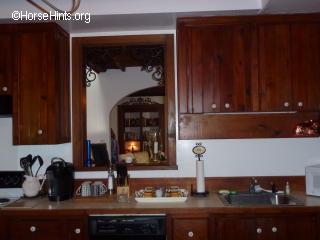 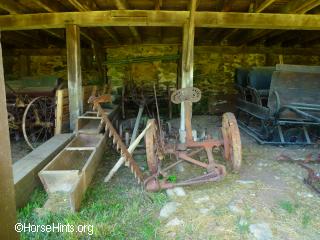 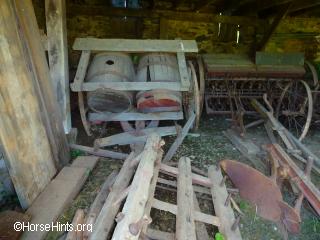 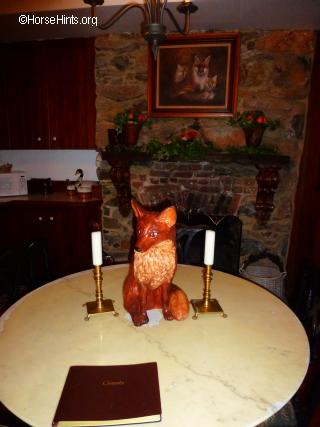 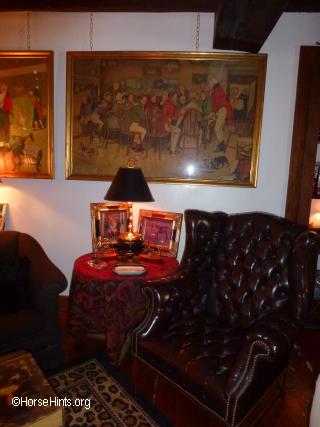 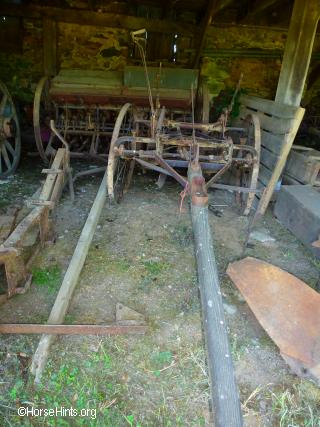  Some out buildings including overseer's house. The 400-acre estate owned by Mrs. Samuel F. Bogley was originally part of a 9600 acre land grant from Lord Fairfax to Robert "King" Carter in 1721. Today Bollingbrook is a working horse and cattle farm and a haven to many rescued animals. The farm features 17 interesting buildings. At the 525-foot long stone barn complex are the scale house, blacksmith shop, overseer house, cannery, "Hilleary House," and the oldest in-ground silo in the state of Virginia, the top of which has been converted into four broodmare stalls. Surrounding the main house, circa 1809, are the slave church, school house, smokehouse, summer kitchen, gardener's cottage and two gate houses. Bollingbrook is mainly a Thoroughbred operation, racing both flat and steeplechase. It also has hunters and does showing and breeding. Bollingbrook has won many championships in sidesaddle, including the National at Madison Square Garden three times, Devon four times, Southampton and Upperville. Other achievements include Upperville Local Hunter, Founder's Cup, National Steeplechase Hurdle Horse of 1975 and winner of the Gallorette Stakes Difference between a Steeplechase Race and a Steeplechase Hurdle "Generally, the difference between a hurdle and the fences in a steeplechase has to do with solidity and height: in a steeplechase race, the fences have a more solid, permanent construction, and may be natural hedge; also, a steeplechase race can include ditches and water jumps, which a hurdle race cannot. The governing body of steeplechase/hurdle racing sets the specifications and definitions of what kind of obstacles are included in races, how they are to be constructed, and the allowable dimensions of the obstacles. Here in America, The National Steeplechase Association sets the specifications for obstacles. National Steeplechase Association In Britain, the National Hunt Steeplechase Committee would be the entity that keeps the specifications that describe the dimensions and construction of fences in steeplechase and hurdle races. Here in America, in addition to racing over hurdles and hedges, we have 'timber racing' over VERY solid timber fences. The  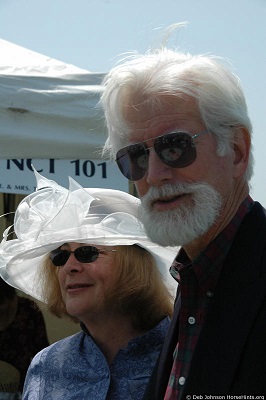
Virginia Gold Cup 2007/Sound Generally, hurdles are constructed so that a horse can safely crash through about the top foot of the hurdle. Hurdlers don't have to jump quite as clean as horses in steeplechases or in timber races." Salem Farm 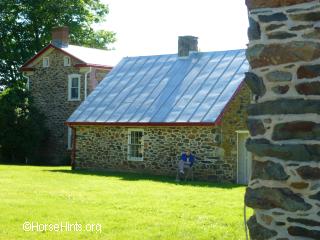 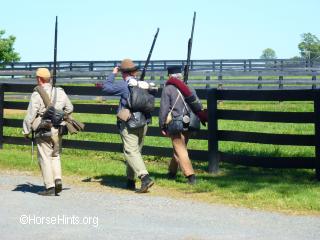 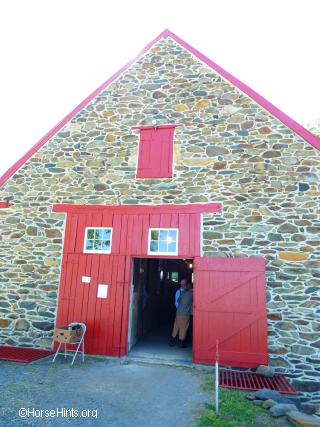 Two level barn with stalls Salem has several fox hunters living here. Owned by Mrs. A.C. Randolph's grandson, Shelby Bonnie, Salem was purchased many years ago from the Peach family and is a Pre-Civil War barn, dated 1852 and 1853 as indicated on the corner stones of the building. The stone barn was originally used as a farm barn for cows, feed and hay. The windows in the tack room were originally 4' high and it is unknown whether they were designed to people in or out. Many famous horses were boarded here, such as Horse of the Year Bon Nouvel, A Part of historic Oakley Plantation, the land around Salem Stable was the site of the beginning of the Battle of Upperville during the Civil War. As the federal troops pushed towards the Ashby Gap, the Confederate troops attempted to slow their progress in order to prevent them from seeing General Lee's build-up in the Shenandoah Valley before his advance North to Gettysburg. Re-enactors for both the Confederate and Federal troops were demonstrating camp life during the Civil War at Salem Stable. Campaign: Location: Loudoun County/Campaign: Gettysburg Campaign (June-August 1863)  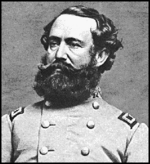 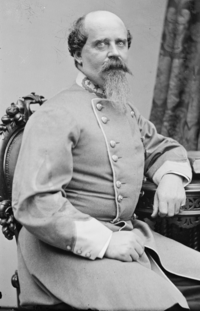 Maj. General Alfred Pleasonton, Brig.General Wade Hampton and General Beverly Robertson, respectively Description: On June 21, Union cavalry made a determined effort to pierce Stuart's cavalry screen. Hampton's and Robertson's brigades made a stand at Goose Creek, west of Middleburg, and beat back Gregg's division. Buford's column detoured to attack the Confederate left flank near Upperville but encountered William E. "Grumble" Jones's and John R. Chambliss's brigades while J.I. Gregg's and Kilpatrick's brigades advanced on the Upperville from the east along the Little River Turnpike. After furious mounted fighting, Stuart withdrew to take a strong defensive position in Ashby Gap, even as Confederate infantry crossed the Potomac into Maryland. As cavalry skirmishing diminished, Stuart made the fateful decision to strike east and make a circuit of the Union army as it marched toward Gettysburg. CWSAC Battle Summaries Banbury Cross Farm "Banbury Cross Farm is located just east of Middleburg off of Highway 50 and Carters Run Lane. It is the home of the Gunnell Family and the Banbury Cross Polo Ponies, but the main focus of this part of the farm is the Foxhunter Barn, where MB Stables, run by Mo Baptiste, operates her training and boarding facility. Flanked by a riding ring, schooling flat field, and cross country schooling field, the large Jeffersonian Style barn is made of red brick and has 18 stalls. There is a constructed indoor arena making it possible for riders and horses to train year-round. The Foxhunter Barn is home to Foxhunters, show horses, eventers, and lesson horses. Also on the farm are three other barns that house green horses, sale horses, and mares and foals. A working farm, Banbury Cross Farm is a place where horses of most types can grow from foals to young horses being trained as beginners in their chosen discipline to mature into happy, functional adult horses. ..." Unfortunately Bill and I did not have time to see Banbury Cross Farm. However, I am sure that we will have that opportunity in the Hunt Country Stable Tours to come. All of the other stops we have seen previously as well as many more not listed this year. 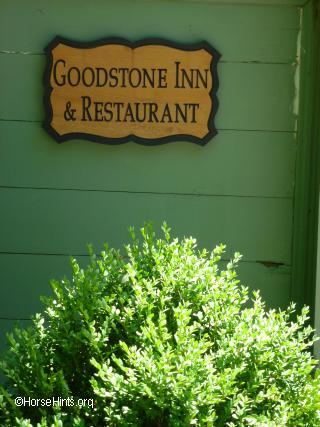   The sign in front of the restaurant (left) and a horse hitching post (right). Below a deer in the field as we approached the restaurant. Bill and I had reservations to enjoy Sunday Brunch at 1:00 PM. We thought that would be the perfect time to take a break for lunch. "Goodstone Inn is in the heart of Northern Virginia's wine and hunt country. ...In the 1700's, Middleburg, Virginia was a stopping point for weary travelers. Not much has changed. ..." There is lots to see if you have the time including: "The Carriage House, The Dutch Cottage, The Spring House, The French Farm Cottage, The Bull Barn and The Manor House." We very much enjoyed our Sunday Brunch. It was most relaxing and our cuisine was perfect. |